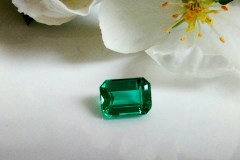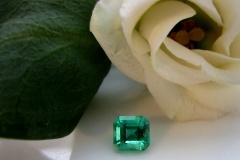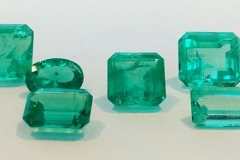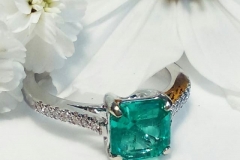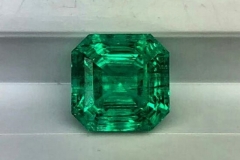Ural Emerald
A gem is beautiful, rare, and timeless. This circumstance alone explains the belief in the mysterious magical power of the precious stone, in the ability of amulets and talismans made of it to interfere with human fate — to protect and save, to grant happiness and talent, but sometimes to attract evil fate.
Different peoples at different times have shown an inexplicable tendency to one particular stone. The emerald was loved and valued everywhere and at all times.
Natural emerald crystal of good jewelry qualities is a rare miracle. That’s why it’s so expensive.
Emerald is a magical green stone with a charming radiance and the main competitor of a diamond in the world of jewelry. This magnificent stone has been highly valued for thousands of years by the rulers of the world and in the religions of the world.
The quality of an emerald is determined by its color and transparency. Bright green transparent stones with a rich color can cost more than diamonds. In addition, the price is affected by the size of the emerald, as small stones are much more common.
There are many deposits of emeralds on our planet. Each of them is beautiful in its own way. The richest deposits of emeralds are found in Colombia, but they are also found in Zambia, Brazil, Zimbabwe, Madagascar, Pakistan, India, and Afghanistan.
At the same time, emeralds from different mines differ, and the characteristics can determine the birthplace of the stone.
Today we want to present you the world-famous Russian emerald, let you in on the secrets of its history and provide a unique opportunity to purchase in your collection or give your loved ones a natural Ural emerald Malyshevsky Deposit, which is characterized by delicate soft shades and the highest quality.
The main emerald-beryllium deposits not only in Russia, but throughout Europe are concentrated in the Urals.
The richest emerald veins were discovered here in the 1830s, when farmers began to find precious stones on their plots.
Near the village of Malyshev, 60 km from Yekaterinburg, there is an emerald Deposit 25 km long and 2 km wide, the only Deposit on the Eurasian continent. In 1830, the smolokur Maxim Kozhevnikov found several iridescent transparent green stones in the roots of a turned-out tree. The stones fell to the commander of the Yekaterinburg granite factory, Yakov Kokovin, and on January 27, 1831, the richest emerald mines were opened. The Sretensky mine began its work.
In 1834, Yakov Vasilyevich Kokovin laid the Mariinsky mine here, named in honor of Saint Mary of Egypt and became part of the complex of the emerald mines of the Urals.
The discovery of emeralds in the Urals made a real furore in St. Petersburg and since then the best emeralds immediately after processing were sent directly to the Imperial court. By 1862, 142 poods (2,272 kg) of emeralds were mined in the Urals.
The Mariinsky vein was very rich in green stones. Initially, the stones were only extracted at the mine, and processing was carried out in other places. So, for the first 10 years in Peterhof, 5 thousand carats of Mariinsky emeralds were stolen. In 1899, the mine was leased by an Anglo-French company, which organized the processing of stones on the site.
In 1919, the Mariinsky mine was nationalized by the Bolsheviks. In the year of the 10th anniversary of the October revolution, the Priisk is named after the Ural revolutionary I. M. Malyshev. In the 1930s, new mines and an emerald factory were built on the mine. During industrialization, the extraction of precious stones takes a back seat – the growing industry needs beryllium concentrate, obtained from the mineral beryl, and beryllium ligature for rapid-firing aircraft guns and machine guns. Beryllium extracted from the Malyshevsky mine was used as a neutron moderator in the structural elements of the first Soviet atomic bomb and the first reactor of a nuclear power plant.
From 1952 to 1994, the Malyshevskoye mine management company, the city-forming enterprise of the village named after Malyshev, worked at the mine.
In 1996-2007, the field was operated by the canadian company Tsar Emerald International, which during this time was unable to fulfill its obligations and revive the enterprise. In 2008, the mine became part of the state Corporation”Rostekhnologii”. Since that time, the production of emeralds has been gradually restored, the emerald extraction factory has been launched again, and in 2018, the company returns its historical name – the Mariinsky mine.
Malyshevskoye Deposit is a unique Deposit of emeralds, the only one in Russia and one of the largest in the world. For almost 200 years, there has been mining of precious green stone and other minerals. The mine again becomes a city-forming enterprise, and the Ural emeralds regain their former world glory.
According to experts, the reserves of the green gem on the territory of the Malyshevsky Deposit amount to 60 thousand kilograms, and these are only explored deposits. Malyshev emeralds have become a unique brand in the world due to their unique yellowish hue and are highly valued on the world market.
The quality of precious stones extracted from the Deposit is largely due to the technology of their extraction, which allows you to extract the crystals without damage. The ore is beaten off manually or using special non-destructive mixtures, while blasting is prohibited.
The uniqueness of the mine is also due to the fact that the extraction of stones here is carried out by a mine, that is, underground method. Working in a mine is hard physical labor, so it is done by men, and women are better at sorting stones. Every year, the Mariinsky mine processes 94 thousand tons of ore, from which crystal raw materials are extracted with an approximate content of beryls − more than 5 tons, emeralds − 150 kg and alexandrites − 15 kg.
Recently, the Malyshevsky mine has given the World several large gems. In 2012, the mine produced the largest emerald in a decade weighing 637 grams, called “Jubilee”. Less than a year later, Malyshev specialists extracted a large emerald ore with a total weight of about a kilogram. In 2016, two large beryls weighing 5.5 kg and 15 kg were found. In 2018, an emerald weighing 1,540 grams was extracted, which was named “Maryin Dar”after an open competition. And in may 2019, the record was again broken by a rare emerald weighing 1.6 kg.
Distinctive features that Russian emeralds are valued for all over the World:
- emeralds have a richer color, so the hardness and refraction index of the rays is better;
- stones have fewer impurities and defects that spoil the appearance;
- the cost of stone mining in Russia is relatively small, and the reserves of deposits will last for more than one year.
Five types of emeralds are distinguished by the color of the stones: from dark green (the first color) to weak green (the fifth color). Accordingly, the darker the stone, the more expensive it is.
The cost is also determined by the purity of the mineral.
The nature of the emerald implies the presence of inclusions and impurities. If the stone is absolutely pure, then this should alert you when buying and suggest the idea of an artificial origin of the mineral. In the Ural emeralds, there are much fewer impurities and cracks than in emeralds from other world deposits, but they are still there.
Stones are classified by the number of inclusions in the following categories:
G1 — rare inclusions, almost invisible to the eye;
G2 — thickening and networks of inclusions in certain areas of the stone are visible without a magnifying glass;
G3 — networks and thickening on the entire surface of the stone, visible to the eye.
All these categories, as well as the weight of the stone, determine its cost.
Emerald is a really beautiful and noble representative. Its properties that attract good luck to the owner, as well as the ability to develop intuition and give wisdom are valued among lovers of jewelry and stones. Emerald looks good in combination with other minerals.

